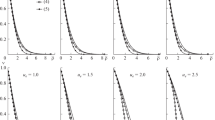Abstract
The problem of modeling the motion, ablation, and energy deposition of a meteoroid or its fragments moving as a single body is considered. A computer program for calculating the system of meteor physics equations by the Runge–Kutta method is created and tested. The equations take into account the curvilinearity of the trajectory of the meteor body, gravity, and a change in the heat-transfer coefficient along the trajectory. Test calculations are performed for meteor bodies of various sizes moving in the atmosphere. A change in the trajectory angle with respect to the horizon depending on the initial parameters of entry into the atmosphere is shown. The effect of taking into account the variability of the trajectory angle on a change in the velocity, mass loss, kinetic energy, and trajectory of the meteoroid is estimated.









Similar content being viewed by others
REFERENCES
Grigoryan, S.S., Meteorites motion and destruction in planet atmospheres, Cosmic Res., 1979, vol. 17, no. 6, pp. 875–893. http://adsabs.harvard.edu/abs/1980CosRe..17..724G
Melosh, H.J., Atmospheric breakup of terrestrial impactors, Proc. Lunar Planet. Sci. A, 1981, vol. 12, pp. 29–35. http://adsabs.harvard.edu/full/1981mrbf.conf…29M
Chyba, C.F., Thomas, P.J., and Zahnle, K.J., The 1908 Tunguska explosion – atmospheric disruption of a stony asteroid, Nature, 1993, vol. 361, pp. 40–44. https://www.nature.com/articles/361040a0
Hills, J.G. and Goda, M.P., The fragmentation of small asteroids in the atmosphere, Astron. J., 1993, vol. 105, no. 3, pp. 1114–1144. http://adsabs.harvard.edu/full/1993AJ….105.1114H
Grigoryan, S.S., Ibodov, F.S., and Ibadov, S.I., Physical mechanism of Chelyabinsk superbolide explotion, Solar Syst. Res., 2013, vol. 47, pp. 268–274. https://doi.org/10.1134/S0038094613040151
Brykina, I.G., Large meteoroid fragmentation: modelling the interaction of the Chelyabinsk meteoroid with the atmosphere, Solar Syst. Res., 2018, vol. 52, pp. 426–434.
Brykina, I.G., Bragin, M.D., and Egorova, L.A., On models of meteoroids fragmentation in the atmosphere, Fiz.-Khim. Kinet. Gaz. Din., 2019, vol. 20, issue 2. http://chemphys.edu.ru/issues/2019-20-2/articles/822/
Baldwin, B. and Sheaffer, Y., Ablation and breakup of large meteoroids during atmospheric entry, J. Geophys. Res., 1971, vol. 76, pp. 4653–4668. https://agupubs.onlinelibrary.wiley.com/doi/abs/10.1029/JA076i019p04653
Nemchinov, I.V. and Popova, O.P., An analysis of the 1947 Sikhote-Alin event and a comparison with the phenomenon of February 1, 1994, Solar Syst. Res., 1997, vol. 31, pp. 408–420. https://ui.adsabs.harvard.edu/abs/1997SoSyR..31..408N/abstract
Ceplecha, Z., Borovička, J., Elford, W.G., ReVelle, D.O., Hawkes, R.L., Porubcan, V.Í., and Šimek, M., Meteor phenomena and bodies, Space Sci. Rev., 1998, vol. 84, pp. 327–471. https://link.springer.com/article/10.1023%2FA%3A1005069928850
ReVelle, D.O., NEO fireball diversity: energetics-based entry modelling and analysis techniques, in Proc. Int. Astronomical Union Symp., Cambridge Univ. Press, 2007, vol. 236, pp. 95–106. https://doi.org/10.1017/S1743921307003122
Avramenko, M.I., Glazyrin, I.V., Ionov, G.V., and Karpeev, A.V., Simulation of the airwave caused by the Chelyabinsk superbolide, J. Geophys. Res. Atmos., 2014, vol. 119, pp. 7035–7050. https://doi.org/10.1002/2013JD021028
Ceplecha, Z. and ReVelle, D.O., Fragmentation model of meteoroid motion, mass loss, and radiation in the atmosphere, Meteorit. Planet. Sci., 2005, vol. 40, pp. 35–54. https://doi.org/10.1111/j.1945-5100.2005.tb00363.x
Borovička, J., Toth, J., Igaz, A., Spurny, P., Kalenda, P., Haloda, J., Svoren, J., Kornos, L., Silber, E., Brown, P., and Husarik, M., The Košice meteorite fall: atmospheric trajectory, fragmentation, and orbit, Meteorit. Planet. Sci., 2013, vol. 48, pp. 1757–1779. https://doi.org/10.1111/maps.12078
Borovička, J., Spurny, P., Brown, P., Wiegert, P., Kalenda, P., Clark, D., and Shrbeny, L., The trajectory, structure and origin of the Chelyabinsk asteroidal impactor, Nature, 2013, vol. 503, pp. 235–237. https://doi.org/10.1038/nature12671
Wheeler, L.F., Register, P.J., and Mathias, D.L., A fragment-cloud model for asteroid breakup and atmospheric energy deposition, Icarus, 2017, vol. 295, pp. 149–169. https://doi.org/10.1016/j.icarus.2017.02.011
Borovička, J., Popova, O., and Spurný, P., The Maribo CM2 meteorite fall – survival of weak material at high entry speed, Meteorit. Planet. Sci., 2019, vol. 54, pp. 1024–1041. https://doi.org/10.1111/maps.13259
Bronshten, V.A., Fizika meteornykh yavlenii (Physics of Meteoric Phenomena), Moscow: Nauka, 1981.
Stulov, V.P., Mirskii, V.N., and Vislyi, A.I., Aerodinamika bolidov (Fire-balls Aerodynamics), Moscow: Nauka, 1995.
Meshcherskii, I.V., Raboty po dinamike tel peremennoi massy (Scientific Works on Variable-Mass Body Dynamics), Moscow: Izd. Tekhniko-Teoreticheskoy Literatury, 1952.
Astapovich, I.S., Meteornye yavleniya v atmosphere Zemli (Meteor Phenomena in the Earth’s Atmosphere), Moscow: Izv. Fiz.-Mat. Lit., 1958.
Levin, B.Yu., Fizicheskaya teoriya meteorov i meteornoe veshchestvo v solnechnoi sisteme (Physical Theory of Meteors and Meteor Matter in the Solar System), Moscow: USSR Acad. Sci., 1956.
Brykina, I.G. and Egorova, L.A., Approximation formulas for the radiative heat flux at high velocities, Fluid Dyn., 2019, vol. 54, pp. 562–574. https://doi.org/10.1134/S0015462819040037
Johnston, C.O., Mazaheri, A., Gnoffo, P., Kleb, B., Sutton, K., Prabhu, D., Brandis, A.M., and Bose, D., Radiative heating uncertainty for hyperbolic Earth entry, part 1: flight simulation modeling and uncertainty, J. Spacecraft Rockets, 2013, vol. 50, no 1, pp. 19–38. https://doi.org/10.2514/1.A32254
Brykina, I.G. and Bragin, M.D., On models of meteoroid disruption into the cloud of fragments, Planet. Space Sci., 2020, vol. 187, no. 104942. https://doi.org/10.1016/j.pss.2020.104942
Turchak, L.I., Osnovy chislennykh metodov: uchebnoe posobie dlya studentov vuzov (Foundations of Numerical Methods. Student’s Book for Universities), Moscow: Vysshaya Shkola, 1987.
Brykina, I.G. and Tirskiy, G.A., Mass loss and light curve of a large meteoroid. Analytical solution, J. Appl. Math. Mech., 2017, vol. 81, pp. 395–408. https://doi.org/10.1016/j.jappmathmech.2018.03.008
Suttles, J.T., Sullivan, E.M., and Margolis, S.B., Curve fits of predicted inviscid stagnation-point radiative heating rates, cooling factors, and shock standoff distances for hyperbolic earth entry, NASA Technical Note, 1974, no. D-7622. https://ntrs.nasa.gov/archive/nasa/casi.ntrs.nasa.gov/19740021216.pdf.
Funding
The work was carried out in accordance with the research plan of the Institute of Mechanics of Moscow State University, with partial support by the Russian Foundation for Basic Research, project no. 18-01-00740.
Author information
Authors and Affiliations
Corresponding author
Additional information
Translated by E. Seifina
Rights and permissions
About this article
Cite this article
Brykina, I.G., Egorova, L.A. Modeling the Motion, Ablation, and Energy Deposition of a Meteoroid in the Atmosphere Taking into Account the Curvilinearity of the Trajectory. Fluid Dyn 58, 701–711 (2023). https://doi.org/10.1134/S0015462823600979
Received:
Revised:
Accepted:
Published:
Issue Date:
DOI: https://doi.org/10.1134/S0015462823600979



